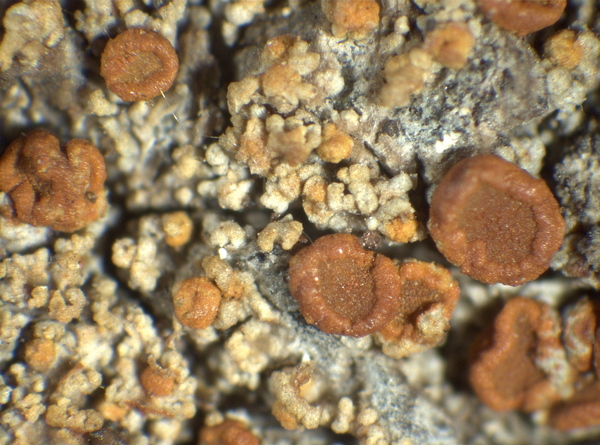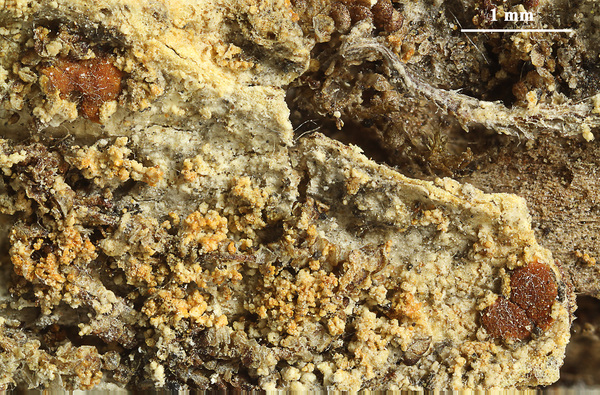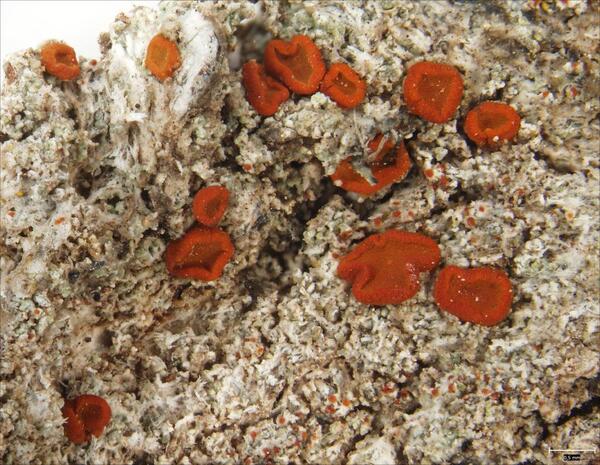Blastenia coralliza (Arup & Åkelius) Arup, Søchting & Frödén
Nord. J. Bot., 31: 67, 2013. Basionym: Caloplaca coralliza Arup & Åkelius - Lichenologist, 41: 471, 2009.
Synonyms: Blastenia viperae Zahlbr. ?; Caloplaca viperae (Zahlbr.) H. Olivier ?
Distribution: N - VG (TSB 11262), Emil (Arup & Åkelius 2009, Vondrák & al. 2020, Fariselli & al. 2020). C - Tosc (Arup & Åkelius 2009), Laz, Sar (Vondrák & al. 2020). S - Pugl (TSB 2230), Cal (Vondrák & al. 2020), Si (Herb. Malícek 7591).
Description: Thallus crustose, episubstratic, continuous to cracked-areolate, more or less densely covered in (50-)56-90(-112) μm tall, beige to orange, rarely grey or green, coralloid isidia. Apothecia biatorine/zeorine, adnate to sessile, round to very irregular in outline, orange to rust-red, with a concave to convex disc and a thin proper margin. Proper exciple 60-85 μm thick, prosoplectenchymatous, of more or less radiating, elongate cells, sometimes containing algae in lower part, C+ purple; epithecium orange, granular, K+ red, C-; hymenium colourless, 80-105 μm high, not inspersed with oil droplets; paraphyses simple or sparingly branched in upper part, 1-2.5 μm thick at mid-level, the apical cells sometimes slightly wider; hypothecium colourless or very pale brown, 50-110 μm high, often inspersed with oil droplets. Asci 8-spored, clavate, functionally unitunicate, apically thickened with a broad internal beak, the inner part of apex and external cap I+ blue, Teloschistes-type. Ascospores 2-celled, polarilocular, hyaline, ellipsoid, 10-15 x 4-9 μm, the equatorial thickening (“septum”) (3-)3.5-4(-5) μm, c. 1/3 of spore length. Pycnidia rare, immersed, with a red ostiole. Conidia bacilliform to narrowly ellipsoid, 3-5 x 0.8-2 μm. Photobiont chlorococcoid. Spot tests: orange parts of thallus and apothecia K+ purple red; margin of apothecia and tips of pycnidia C+ purple. Chemistry: non-chlorinated anthraquinones in apothecial disc, chlorinated anthraquinones in exciple and tips of pycnidia; thallus without or with anthraquinones; Cinereorufa-green pigment present only in traces (in prothallus and tips of pycnidia).Note: A recently-described, Mediterranean-Macaronesian and Mediterranean-Atlantic species reaching Southern Scandinavia, but absent from most of Central Europe, more frequent at lower altitudes than B. herbidella. It might be that several samples of B. herbidella found in lowland areas of Central-Southern Italy could belong to this taxon.
Growth form: Crustose
Substrata: bark and lignum
Photobiont: green algae other than Trentepohlia
Reproductive strategy: mainly asexual, by isidia, or isidia-like structures (e.g. schizidia)
Commonnes-rarity: (info)
Alpine belt: absent
Subalpine belt: absent
Oromediterranean belt: absent
Montane belt: extremely rare
Submediterranean belt: extremely rare
Padanian area: absent
Humid submediterranean belt: very rare
Humid mediterranean belt: rare
Dry mediterranean belt: very rare

Predictive model
Herbarium samples
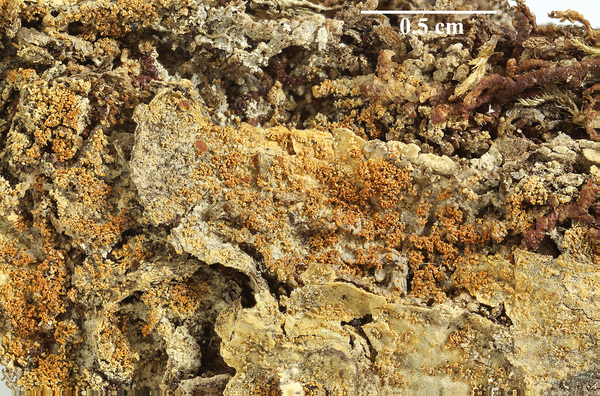
Felix Schumm - CC BY-SA 4.0
[BR5030012897935], Belgium, chêne, bois St. Michel à la limite communale avec Nassogne; Tenneville (St. Hubert). Leg. E. Jacques (6810), 22.06.1969.
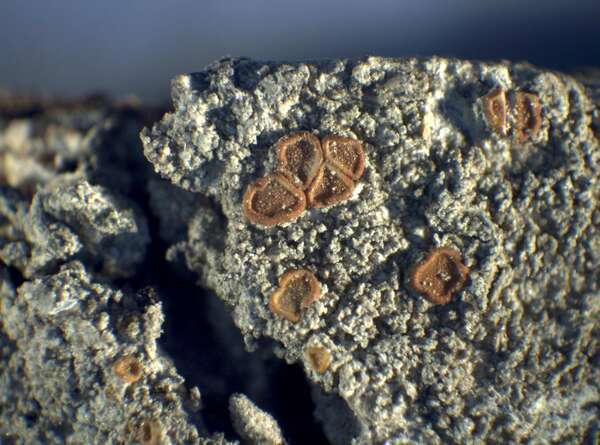

P.L. Nimis; Owner: Department of Life Sciences, University of Trieste
Herbarium: TSB (9523)
2001/11/13
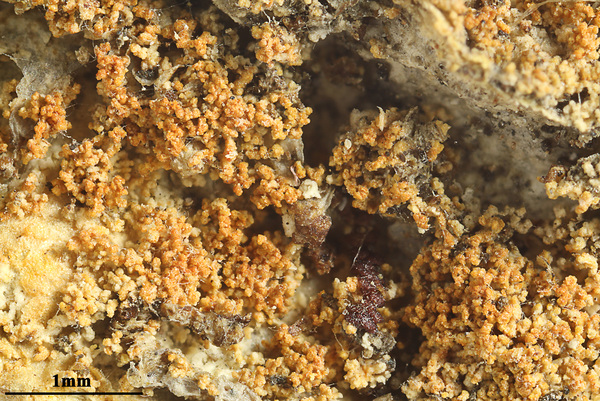
Felix Schumm - CC BY-SA 4.0
[BR5030012897935], Belgium, chêne, bois St. Michel à la limite communale avec Nassogne; Tenneville (St. Hubert). Leg. E. Jacques (6810), 22.06.1969.
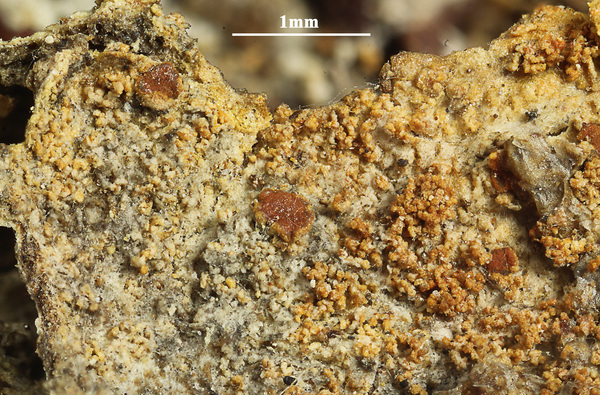
Felix Schumm - CC BY-SA 4.0
[BR5030012897935], Belgium, chêne, bois St. Michel à la limite communale avec Nassogne; Tenneville (St. Hubert). Leg. E. Jacques (6810), 22.06.1969.
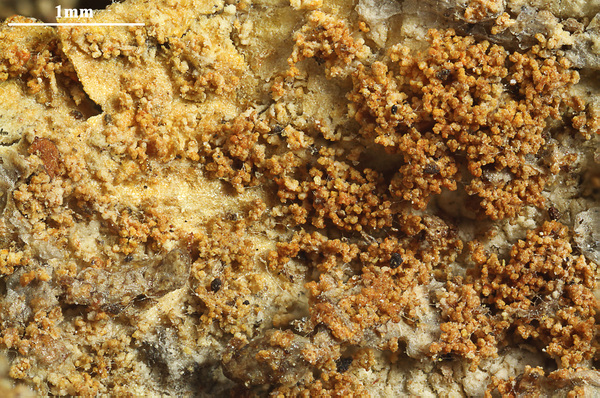
Felix Schumm - CC BY-SA 4.0
[BR5030012897935], Belgium, chêne, bois St. Michel à la limite communale avec Nassogne; Tenneville (St. Hubert). Leg. E. Jacques (6810), 22.06.1969.
Growth form: Crustose
Substrata: bark and lignum
Photobiont: green algae other than Trentepohlia
Reproductive strategy: mainly asexual, by isidia, or isidia-like structures (e.g. schizidia)
Commonnes-rarity: (info)
Alpine belt: absent
Subalpine belt: absent
Oromediterranean belt: absent
Montane belt: extremely rare
Submediterranean belt: extremely rare
Padanian area: absent
Humid submediterranean belt: very rare
Humid mediterranean belt: rare
Dry mediterranean belt: very rare

Predictive model
| Herbarium samples |

Felix Schumm - CC BY-SA 4.0
[BR5030012897935], Belgium, chêne, bois St. Michel à la limite communale avec Nassogne; Tenneville (St. Hubert). Leg. E. Jacques (6810), 22.06.1969.


P.L. Nimis; Owner: Department of Life Sciences, University of Trieste
Herbarium: TSB (9523)
2001/11/13

Felix Schumm - CC BY-SA 4.0
[BR5030012897935], Belgium, chêne, bois St. Michel à la limite communale avec Nassogne; Tenneville (St. Hubert). Leg. E. Jacques (6810), 22.06.1969.

Felix Schumm - CC BY-SA 4.0
[BR5030012897935], Belgium, chêne, bois St. Michel à la limite communale avec Nassogne; Tenneville (St. Hubert). Leg. E. Jacques (6810), 22.06.1969.

 Index Fungorum
Index Fungorum
 GBIF
GBIF
